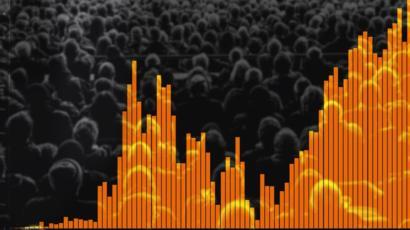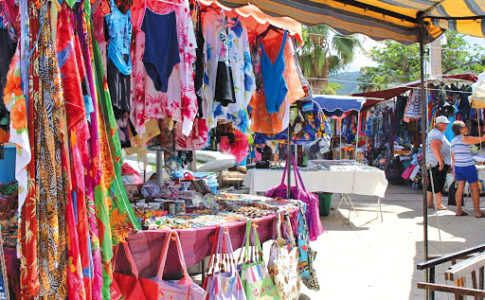The French are gradually forgetting the rigors of confinement due to the coronavirus ... but also physical distancing and barrier gestures. And yet. Epidemiologists are multiplying alert messages. The virus reproduction rate is increasing in five French regions. The global pandemic is accelerating. And the Covid-19 could be favored by fall or winter conditions. So many elements that make the arrival of a second wave likely in France.
The question is not whether there will be a second wave of coronavirus contamination in Europe, and particularly in France, but WHEN it will occur and how large it will be.
Now that the infections are clearly going down, people think it's over. But it is not.

People dance at the Fête de la Musique last Sunday in Paris without any measure of protection and distancing
And yet ... Sunday, June 21, on the occasion of the Fête de la musique in Paris, we saw scenes of jubilation, dancing and collective, and almost no one who was not wearing a mask.
If the virus is under control in France, it is still circulating. Worse, he sees his reproduction rate dangerously increase in several French regions. In addition, the pandemic is accelerating worldwide, warns the WHO. And the virus could well see its expansion favored by the fall or winter conditions.
Epidemiologists sound the alarm
They are everywhere. On the radio, on television sets, on websites and social networks, in newspapers. They multiply the warnings, the calls to reason, to caution, not to forget the physical distancing and the barrier gestures.
Epidemiologists, doctors and virologists obviously understand the need for freedom of the French after two and a half months of confinement, which is more so when the weather is good and when health statistics are more reassuring. But find guilty the lightness of some citizens in the face of a virus that has by no means disappeared.
New cases of Covid-19 have appeared in recent days in certain countries which nevertheless seemed to have the epidemic under control, such as China or New Zealand.
Reproduction rate is greater than 1 in five French regions
The reproduction rate "R0" is one of the indicators which makes it possible to assess the transmission and circulation of the virus on the territory. A value greater than 1 indicates that the epidemic is growing.
Between June 6 and 12, five regions have a reproduction rate greater than 1. In Auvergne Rhône-Alpes it is 1,02, in Occitanie 1,51, in Martinique 1,57, in Normandy 1,6 and in Guyana 2,59 !! In these territories, the virus is actively circulating.
With deconfinement, there remain only the barrier measures to lower this reproduction rate. These data show that we must remain hypervigilant, because the epidemic could restart very quickly.
The global pandemic is accelerating
In France, some might have the impression that the coronavirus is a thing of the past. Nothing could be further from the truth. In Europe, as elsewhere on the planet.
There have been a million new cases in the past eight days. This shows that the pandemic continues to accelerate.
Nine million infections worldwide, more than 120000 dead in the United States, a virus more virulent than ever in Asia and South America: the World Health Organization, which takes a dim view of the many countries that increasingly deconfining their populations, wishes to alert the authorities and public opinion, eager to anticipate both a return to the crisis and a backlash - it was strongly criticized for its management at the start of the epidemic in China.
Still, she is not wrong. Because, on Sunday, nearly 183000 people tested positive for Covid-19 worldwide - a record in 24 hours since the start of the epidemic.
To all these figures, we can add that Germany has just - for the first time - reintroduced two local confinements on its territory, which concern no less than 640000 people. A decision linked to the appearance of an outbreak of contamination in a large slaughterhouse where more than 1500 cases of infections have been detected.
In addition, some countries are already affected by a second wave. This is the case of China, Iran, India and South Korea, which admitted on Tuesday that it has been fighting since mid-May against a second wave of coronavirus, with between 35 and 50 new cases are identified every day, mainly in Seoul and the surrounding area.
The virus could be sensitive to the seasons
We are entering here an area where certainties are lower. But there are indications that the Covid-19 may be sensitive to heat - and that it would prefer cold and humidity to grow.
If we look at the history of the great pandemics of respiratory viruses, we see that eight out of ten regress in European countries spontaneously during the summer. On the other hand, you have five out of ten who reoffend in the fall.
An increase in the circulation of Covid-19 in the northern hemisphere at a more or less distant time (a few months, and especially with the approach of winter) is extremely probable, estimates the group of experts in charge of lighting the government on the evolution of the epidemic.
An opinion also expressed in the United States by the director of the national institute of infectious diseases, Anthony Fauci: it is probable that the Covid-19 can return according to seasonal cycles, the American expert underlining that the coronavirus started to spread in the countries of the southern hemisphere, where winter is coming.
The question is not whether there will be a second wave of coronavirus contamination in Europe, and particularly in France, but WHEN it will occur and how large it will be.
Now that the infections are clearly going down, people think it's over. But it is not.
Without a vaccine, the coronavirus could continue to infect a large part of the population
Why ? Because the droplets expelled by patients remain longer in the open air in the cold, and the immune defenses are weakened in winter. But also because viruses degrade faster on hot surfaces, the protective layer of fat that envelops them dries faster.
In many countries s in the southern hemisphere, with the approach of the austral winter, Argentina, Chile, southern Brazil and South Africa are experiencing strong epidemic growth which reminds us of ours a few months ago.
s in the southern hemisphere, with the approach of the austral winter, Argentina, Chile, southern Brazil and South Africa are experiencing strong epidemic growth which reminds us of ours a few months ago.
Many experts are indeed cautious on the issue. Summer warming alone will not save the northern hemisphere from the pandemic, researchers from the American Princeton University say in a study published two weeks ago by the journal Science. We expect warmer, wetter climates will not slow the virus in the initial stages of the pandemic, says Princeton researcher and study co-author Rachel Baker.
In fact, the authors of this study explain, given the low collective immunity against Covid-19, the virus will spread quickly, whatever the weather. And, in the absence of control measures or a vaccine, they add, it will gradually contaminate a larger part of the population. It was only after that he could become seasonal, like his cousins.
As proof of the difficulty in settling this debate, Professor Didier Raoult, who initially said he did not believe in a second wave of coronavirus in France, was more cautious in a video published last Wednesday.
We do not know what will become of the distribution of the current coronavirus, admits the director of the Mediterranean IHU. It may be like the other coronaviruses: there is another time of the winter or spring season with a new epidemic peak. Or it may disappear.
It will be necessary to observe the evolution of the epidemic in New Zealand, which has climatic conditions fairly close to those of France and is currently entering its winter season: if there is an epidemic in New Zealand in the weeks which come, we can fear that there will be the same type of epidemic next winter in France, because that's how it happens for most respiratory infections.
In any event, what would be the government's response to a second wave of Covid-19? The idea of a new containment seems to have been ruled out. The response strategy, in particular to protect the most vulnerable without resorting to a general reconfiguration, as well as the health system, will be presented by the government in the coming days. Special arrangements will be made for the summer, said Matignon on Saturday. In the meantime, indicators of the evolution of the epidemic will continue to be closely scrutinized. Because, it is a certainty, the epidemic is far from over.
Antigua has just reported 39 new cases imported in recent days.
European Union member states plan to ban nationals of several countries, including the United States
The EU and its member countries are in the process of deciding which travelers would be considered safe to visit the European Union from July 1. This criterion will focus on “virus circulation”. Among the countries affected by this ban are, in addition to the United States, Russia, Brazil and Qatar.
In the United States, Texas, which was deconfined in May, recorded 5000 new infections on Tuesday, a record since the start of the pandemic.
California and Florida also set records for new cases. Nationwide, 38386 new cases were reported on Tuesday, June 23 in the United States, the third highest number of new cases reported in one day since the start of the pandemic.
We can clearly see on the graph above that the number of new cases in the USA has been on the rise in recent days.
According to an article www.ouest-france.fr
Editor's note: The long-awaited reopening of Juliana to revive the island's economy, could be one of the sources of resumption of the epidemic, like all the other routes of entry to the island. When we hear the measures that the EU is about to take, not sure that the American nationals (north and south) will finally be accepted in Juliana by the government of Sint-Maarten.
So let's be vigilant for everyone's health and for our island and continue to apply barrier gestures IMPERATIVELY
7,293 total views







No comments